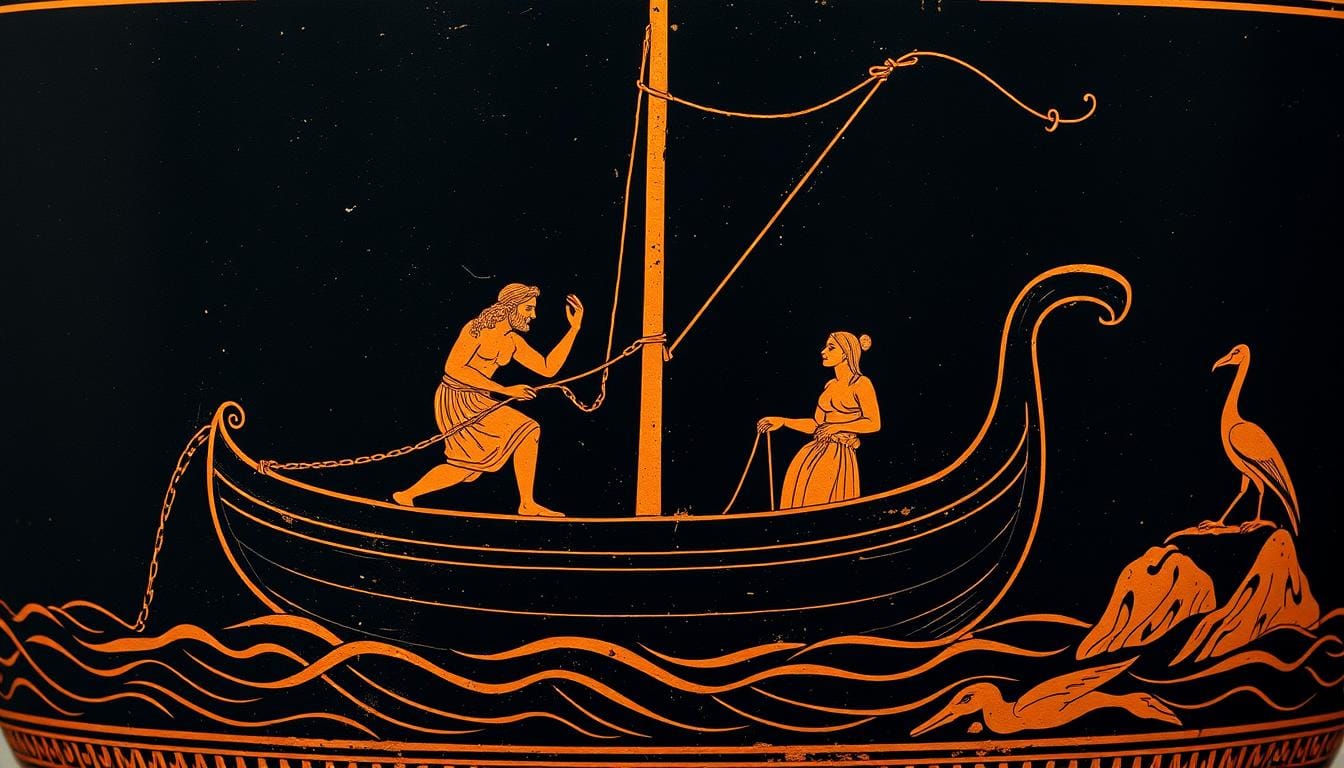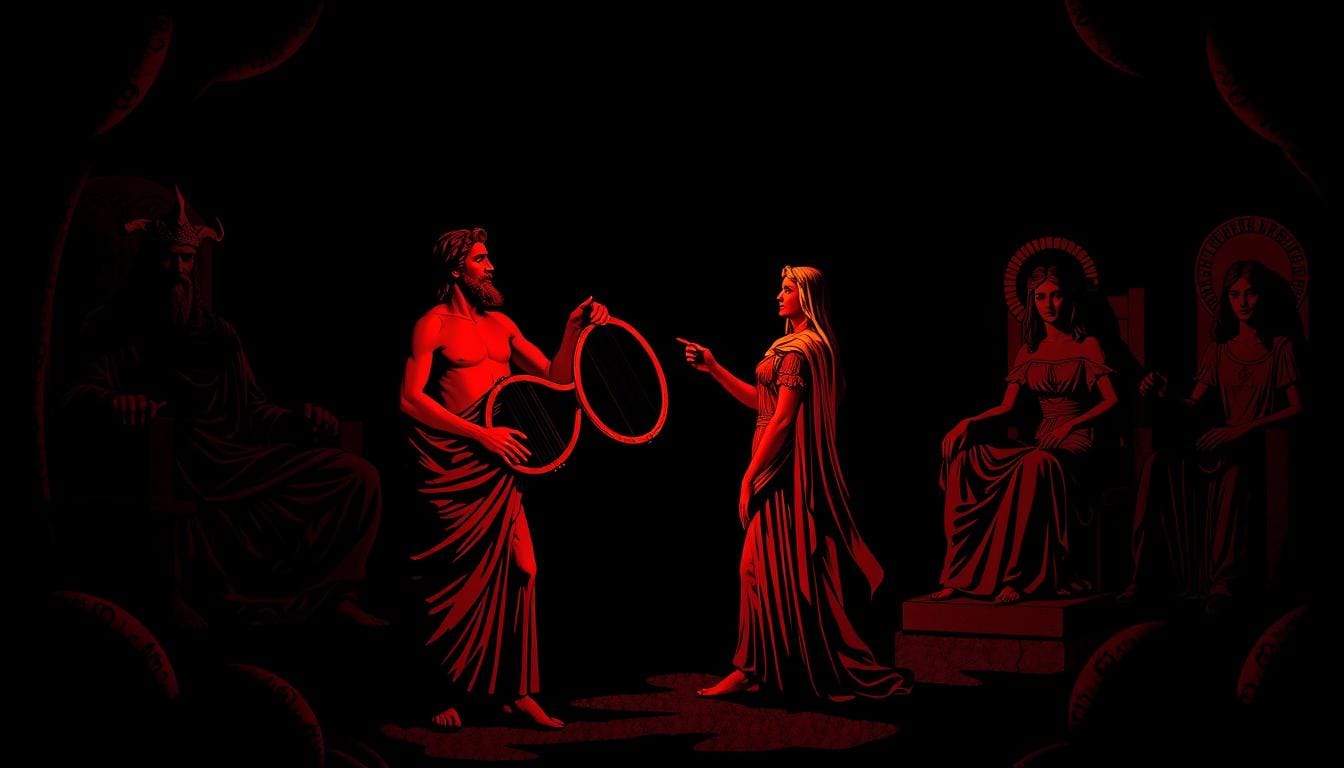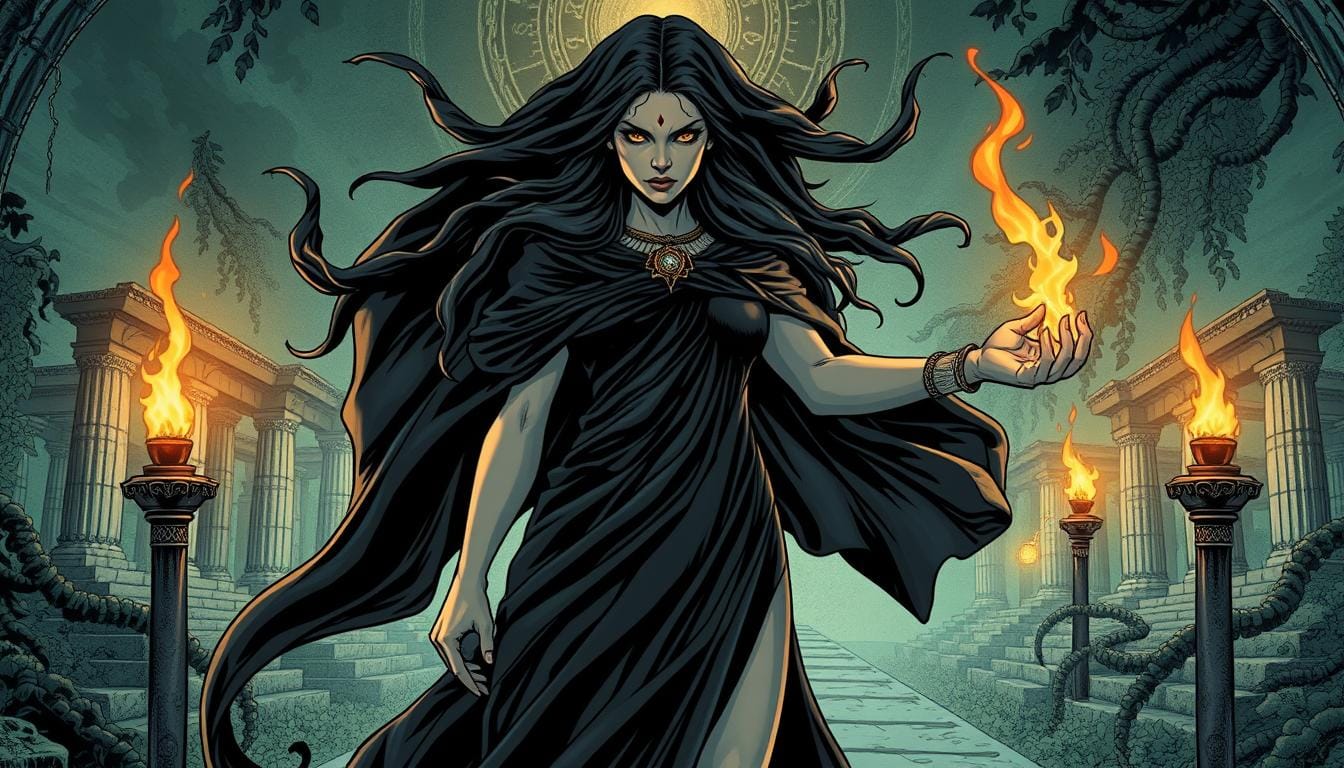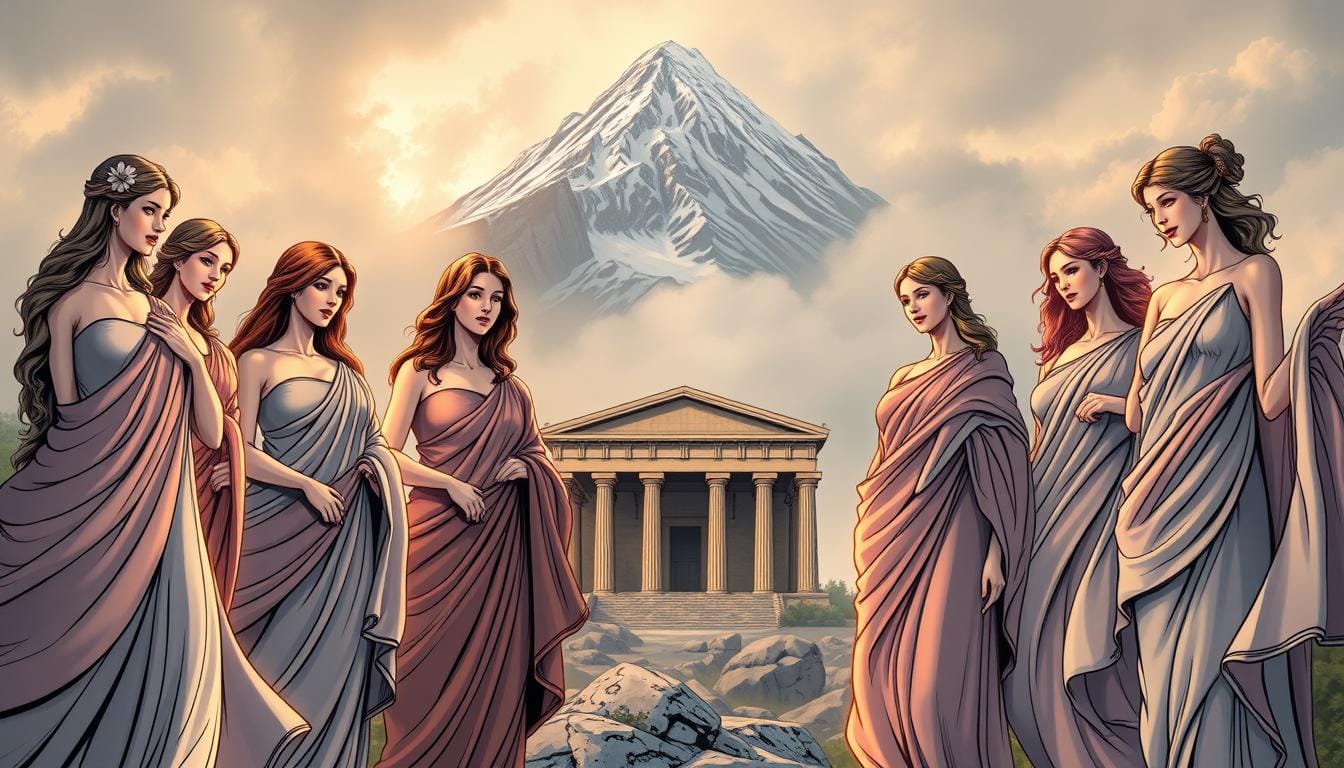In ancient Greece, every single sacrifice started with a gift to Hestia. Yet, today, many have never heard of her. Hestia, the virgin goddess of the hearth and home, played a vital role in society. Despite being overlooked, she was key among the Olympians.
Hestia was a unique goddess. She was both the first-born of the Titans Cronus and Rhea and also the youngest. Her father, Cronus, ate his children, but Hestia was saved last by Zeus.
Her choice to remain a virgin made her the protector of every hearth in ancient Greece. Families needed her sacred fire for warmth, cooking, and protection. Without her, homes couldn’t function.
Unlike her siblings, who were famous for their adventures, Hestia kept the heart of Greek civilization. She did this through domestic life and strong community ties.
Key Takeaways
- Hestia was the first-born child of Titans Cronus and Rhea, making her the eldest Olympian deity
- She chose eternal virginity and became the protector of all hearths and homes in ancient Greece
- Every domestic sacrifice in ancient Greek culture began with an offer to Hestia first
- Despite her fundamental importance, she remains one of the least known Olympian gods today
- Her sacred fire was essential for family survival, providing warmth, cooking, and spiritual protection
- She represented the peaceful, nurturing aspects of ancient Greek mythology, unlike dramatic conflicts
Who is Hestia in Greek Mythology?
Hestia’s story starts with family drama, making her the sacred flame keeper. Born into the world of ancient Greek gods, she turned tragedy into a revered role. Her journey from victim to protector made her the beloved family guardian for centuries.
Unlike her siblings who sought power, Hestia chose a different path. She focused on keeping homes warm and harmonious. Her story shows how even peaceful gods can come from darkness.
Origin and Family Background
Hestia was born to Titans Cronus and Rhea, amidst fear and prophecy. Cronus feared being overthrown by his children, just like he was by his father. This fear led him to a terrible decision.
As soon as Hestia was born, Cronus swallowed her. This was to prevent the prophecy from happening. But it only delayed it, creating a mythological paradox for Hestia.
Years later, Zeus defeated Cronus and made him spit out his children. Hestia was the first to be swallowed and the last to be freed. This made her both the eldest and youngest of her siblings.
Her siblings included powerful gods like Zeus, Poseidon, and Hades. Hera and Demeter, her sisters, were queen of the gods and goddess of harvest, respectively.
Role Among the Olympian Gods
Hestia chose a different path from her ambitious siblings. She became one of the original twelve Olympian gods, focusing on the sacred flame on Mount Olympus.
As family guardian, she was important to every household in ancient Greece. She received the first offerings and libations at sacrifices and feasts. This showed her key role in daily life and family stability.
The following table shows how Hestia’s role differed from her siblings among the Olympians:
| Deity | Domain | Approach to Power | Primary Focus |
|---|---|---|---|
| Hestia | Hearth and Home | Peaceful Service | Family Protection |
| Zeus | Sky and Thunder | Authoritative Rule | Divine Leadership |
| Poseidon | Seas and Earthquakes | Territorial Control | Maritime Dominion |
| Hades | Underworld | Isolated Sovereignty | Death and Afterlife |
Hestia’s commitment to peace and domesticity made her unique. She never married and remained a virgin goddess. This allowed her to focus on protecting the hearth and family bonds.
Her gentle nature and dedication earned her respect from gods and mortals. Unlike other deities, Hestia’s stories highlight stability, warmth, and protection. She symbolized the quiet strength that unites families and communities.
Symbolism of Hestia
Every symbol linked to Hestia told a story about the sacred nature of home and community in ancient Greece. Her name itself reveals deep meaning, derived from the ancient word for “hearth, fireplace, altar” and connected to roots meaning both “burn” and “dwell.” This dual connection between fire and dwelling place captures the essence of what made Hestia so central to Greek life.
The mythology symbolism surrounding Hestia went far beyond simple religious imagery. Her symbols created a bridge between the physical and spiritual worlds. They transformed ordinary household items into sacred objects that connected families to the gods.
Ancient Greeks saw profound meaning in even the simplest representations of their beloved goddess. The humble pig used in her sacrifices spoke to her accessibility. Unlike other gods who demanded expensive offerings, Hestia welcomed gifts from common households.

The Sacred Center of Life
The divine hearth represented much more than a place to cook meals or stay warm. It served as the spiritual heart of every Greek home. Families gathered around this sacred fire to share food, tell stories, and honor their ancestors.
This central flame never went out completely. Greek families carefully tended their hearth fires, understanding that letting them die meant inviting misfortune. The continuous burning represented the unbroken connection between past, present, and future generations.
Public buildings also maintained sacred hearths dedicated to Hestia. These community fires linked individual households to the broader city-state. When Greeks established new colonies, they carried flames from their homeland’s public hearth to light the first fire in their new settlement.
The kettledrum sometimes associated with Hestia added another layer of meaning. Its circular shape echoed the round hearth, while its sound called people together for important ceremonies and community gatherings.
The Protected Boundary
The domestic circle symbolized the protective boundary Hestia created around families. This invisible barrier kept chaos and harm at bay while preserving peace within the home. Greek families understood that crossing this threshold meant entering sacred space.
Hospitality customs grew from this circle concept. Guests who entered a home came under Hestia’s protection. Hosts had sacred duties to provide food, shelter, and safety to visitors. Breaking these rules offended the goddess and brought divine punishment.
The circular nature of the hearth reflected the cyclical patterns of family life. Births, marriages, and deaths all took place within this sacred boundary. Each generation passed down traditions and values around the same central fire.
This domestic circle also represented completeness and unity. Unlike the straight lines and sharp angles found in other architectural elements, the round hearth had no beginning or end. It symbolized the eternal nature of family bonds and community connections.
Hestia's Worship in Ancient Greece
Hestia’s worship was simple yet profound. Unlike other gods, she didn’t need grand temples or festivals. Instead, she was honored through quiet daily rituals in every Greek home.
Her worship was deeply personal and universal. Every household became her sacred space. This made her worship accessible to all, regardless of social status or wealth.
Temples and Rituals
Hestia had few temples compared to other gods. But, cities like Hermione and Sparta built temples for her. This showed her importance in Greek religious life.
Every temple in Greece had a hearth for Hestia. This made her present in all sacred spaces. The prytaneum, or public hearth, was her main sanctuary in each city-state.
Greek colonists took sacred fire from their mother city’s prytaneum to new settlements. This created spiritual bonds between communities. The flame symbolized continuity and divine protection.
Daily rituals honored Hestia with simple acts. Greeks offered her the first and last parts of meals and sacrifices. These acts recognized her role in all domestic activities and religious ceremonies.
Festivals Celebrating Hestia
Hestia’s festivals were different from others. They focused on community gatherings and shared meals, not athletic competitions or performances. These celebrations showed her value of unity over spectacle.
The Hestia Koine was a key festival. Communities came together around public hearths to share food and strengthen bonds. Families brought offerings from their hearths to join the communal celebration.
Local festivals often included Hestia’s worship. City officials lit new fires from her flame during important ceremonies. This reinforced her role in both private and public life.
| Worship Element | Private Practice | Public Practice | Colonial Practice |
|---|---|---|---|
| Sacred Fire | Home hearth maintenance | Prytaneum eternal flame | Mother city fire transport |
| Daily Rituals | First and last meal offerings | Temple libations | Settlement blessing ceremonies |
| Festival Celebrations | Family gatherings | Community feasts | Founding commemorations |
| Sacred Spaces | Household hearths | City prytaneums | New colony centers |
Hestia’s worship created a network of sacred connections across the Greek world. Her influence reached from individual homes to entire civilizations. She was one of the most practically important deities in ancient Greek religion.
Hestia's Influence on Home and Family
In the Greek pantheon, Hestia was the queen of home and family. She made homes sacred places of unity and protection. The ancient Greeks saw Hestia’s power in every family’s daily life.
Hestia watched over important family tasks. She blessed the cooking of bread and meals, making them sacred. Families believed eating together under her watch strengthened their bonds and brought prosperity.

Welcoming newborns at Hestia’s hearth was a beautiful tradition. It welcomed babies into the family and protected them. Parents carried their babies around the fire, asking Hestia for health, happiness, and strong family ties.
Sacred Center of Every Home
The hearth was more than a cooking spot in ancient Greek homes. It was the spiritual heart of the home, with Hestia’s flame providing warmth and protection. Families gathered here for meals, stories, and talks.
Keeping the hearth fire burning was important. It was believed that letting it go out would bring bad luck. The eldest daughter or the mother usually took care of the fire, connecting them to Hestia’s power.
The hearth was also a safe place for guests. Touching the hearth could offer protection, showing Hestia’s role in keeping peace and security in the community.
Divine Guardian of Family Unity
Hestia’s influence was felt in many ways in Greek families. She helped families avoid fights and taught children about respect and loyalty. Parents called on her when teaching these important lessons.
She kept family bonds strong across generations. Grandparents, parents, and children all felt safe in Hestia’s circle. Her presence brought happiness and kept harmony in the family.
Greek families often prayed and made small sacrifices to Hestia. They offered bread, wine, or oil to the fire. The smoke carried their prayers to the goddess, strengthening their bond with her.
| Family Ritual | Hestia’s Role | Symbolic Meaning | Modern Equivalent |
|---|---|---|---|
| Newborn Presentation | Blessing and Protection | Family Acceptance | Baby Blessing Ceremonies |
| Daily Meal Preparation | Sacred Cooking Guidance | Nourishment and Unity | Family Dinner Traditions |
| Hearth Fire Tending | Continuous Divine Presence | Eternal Family Bond | Maintaining Family Traditions |
| Guest Welcome Rituals | Hospitality Protection | Sacred Duty to Strangers | Welcoming House Guests |
Hestia’s practices were woven into Greek family life. She helped create stable, loving homes. Her legacy shows that strong families are the foundation of society.
Comparison with Other Goddesses
Hestia was known for her gentle nature and focus on the home. She was different from other goddesses in ancient Greek mythology. While many had dramatic personalities, Hestia was peaceful and nurturing.
Her choice to remain a virgin set her apart from others like Athena and Artemis. This vow allowed her to help all families, not just one. She wasn’t tied to a single household like others.
The Agricultural Sister vs. The Hearth Keeper
Demeter and Hestia, both daughters of Cronus and Rhea, had different roles. Demeter controlled the external world of agriculture and seasons. Her domain was vast fields and growing crops.
Hestia, on the other hand, looked after the home and hearth. While Demeter’s power affected the harvest, Hestia brought warmth and stability to homes. Demeter’s mood could bring famine or plenty.
Hestia’s calm presence was always there. She offered consistent comfort and security. Together, the sisters showed the importance of both earth’s bounty and home’s warmth in ancient Greek mythology.
Marriage's Queen vs. Domestic Harmony's Guardian
Hestia and Hera had different views on family life. Hera, as Zeus’s wife, was deeply involved in marriage. Her stories often included jealousy, revenge, and the ups and downs of marriage.
Hestia, on the other hand, valued peaceful domestic life. She avoided romantic entanglements. Hera’s tales were full of conflict, but Hestia brought calm and unity.
Hera protected marriage, sometimes fiercely. Hestia focused on harmony within homes. Her gentle approach won the hearts of families seeking peace over passion.
Both goddesses cared about family, but in different ways. Hera’s protection was fierce and vengeful. Hestia’s way was to create safe spaces for families to live together in harmony.
The Artistic Depictions of Hestia
The art of Hestia is a rich study in mythology symbolism. Artists have long tried to show a goddess who shunned the spotlight. Her choice for privacy over fame made it hard to capture her essence in various mediums.
Hestia rarely shows up in old art. This shows her humble nature and focus on home life, not grand adventures. When she was depicted, artists used symbols to show her divine side.

Ancient Art and Sculpture
Artists from ancient times found it tough to show a goddess with few stories. Most images of Hestia show her as a modestly veiled woman with a staff or near a fire. These simple signs were her main visual marks in old art.
The Giustiniani Hestia is a key piece from ancient times. This marble sculpture shows her sitting on a simple throne with a woolen cushion. Her throne’s simplicity shows her connection to all people, unlike other gods’ fancy seats.
Artists always highlighted certain symbols when showing Hestia. Her veil showed her virginity and modesty. Fire or hearth tools showed her role in home life. These symbols helped people know it was her, even if she looked simple.
Modern Interpretations
Today, artists try to show Hestia in new ways. They face challenges because of her lack of exciting stories. Modern art often shows her as a caring, protective figure in cozy settings.
Artists today focus on Hestia’s role as a home and family guardian. They use warm colors and gentle faces to show her caring side. These works mix old symbols like fire with new ideas of home life.
Artists keep finding new ways to show Hestia. Some use abstracts to show warmth and comfort. Others create spaces that feel like home, showing Hestia’s spirit.
| Period | Common Depictions | Key Symbolic Elements | Artistic Challenges |
|---|---|---|---|
| Ancient Greek | Veiled woman with staff | Simple veil, plain throne, fire | Limited dramatic stories |
| Roman | Seated figure near hearth | Domestic tools, modest clothing | Balancing divinity with simplicity |
| Renaissance | Rarely depicted | Flame symbolism when present | Lack of heroic narratives |
| Modern | Nurturing maternal figure | Warm colors, home imagery | Making ancient concepts relevant |
Hestia in Contemporary Culture
Today, people are looking for stability and a sense of home in a chaotic world. Hestia, the goddess of the hearth, is being rediscovered. Her wisdom about domestic life is as relevant now as it was in ancient Greece.
Hestia’s influence is growing because she was often left out of old stories. Unlike other gods, she didn’t appear in Homer’s famous tales. This made her less known in popular culture for a long time.
But, ancient poets like Apollodorus, Hesiod, and Ovid knew her importance. Their writings have helped modern people understand Hestia’s role and significance.
References in Literature and Media
Authors today are exploring Hestia’s significance in new ways. Rick Riordan’s Percy Jackson series introduced many to Greek mythology, including Hestia.
Books that focus on home and belonging often draw from Hestia’s domain. Characters in these stories seek the comfort and security she represents. These tales reflect our desire for stability in uncertain times.
TV shows and movies sometimes mention Hestia when talking about family or home. Her presence adds depth to stories about domestic life and family ties.
Interestingly, Hestia’s Roman counterpart, Vesta, appears more in media. Stories about Vesta and Priapus offer more dramatic material than Hestia’s peaceful Greek traditions.
Hestia in Modern Spiritual Practices
Neo-pagan and modern pagan movements see Hestia as very relevant today. Her focus on home, family, and community resonates with those seeking meaningful connections.
These groups hold hearth blessing ceremonies inspired by ancient Greece. They light candles or fires to express gratitude for home and family. These rituals create sacred spaces in everyday life.
Seasonal celebrations honoring the goddess of the hearth are becoming more popular. These gatherings focus on hospitality, sharing meals, and strengthening community bonds. Participants light fires or candles to honor Hestia in their homes.
Meditation practices centered on fire and domestic spaces come from Hestia’s domain. These practices help find peace and grounding in daily life. Tending a flame becomes a spiritual act.
The rise of “hygge” and similar lifestyle concepts is linked to Hestia’s influence on domestic life. This Danish concept of cozy contentment mirrors the ancient Greek appreciation for hearth and home that Hestia represented.
| Modern Practice | Ancient Connection | Contemporary Benefit | Common Elements |
|---|---|---|---|
| Hearth Blessing Ceremonies | Greek household rituals | Creates sacred home space | Candles, gratitude, intention |
| Seasonal Home Celebrations | Festival of Hestia | Strengthens community bonds | Shared meals, fire lighting |
| Fire Meditation | Tending sacred flame | Promotes inner peace | Focused attention, mindfulness |
| Hygge Lifestyle | Domestic contentment | Reduces stress, increases joy | Comfort, simplicity, presence |
Modern spiritual teachers highlight Hestia’s role as a protector of family harmony. Her gentle approach to divine intervention appeals to those seeking less dramatic spiritual guidance. This makes her attractive to those focused on everyday spirituality.
Online communities dedicated to honoring the goddess of the hearth share recipes, home decoration ideas, and family traditions. These digital spaces extend Hestia’s ancient role as a unifier of communities into the modern world.
Hestia's Values and Lessons for Today
The sacred flame of Hestia’s teachings lights the way to deeper fulfillment. It guides us to live mindfully and connect with our communities. Her wisdom is as relevant today as it was in ancient times, helping us build meaningful homes and relationships.
Hestia’s calm, non-confrontational nature is a breath of fresh air in our aggressive world. Her values of consistency and quiet service show us that true happiness comes from steady, reliable care for others.
Emphasizing Home and Community
Hestia sees home as a sacred space, a concept that resonates with today’s quest for work-life balance. Her teachings encourage us to see our homes as sanctuaries, not just places to live. This changes how we view domestic life and our personal well-being.
The goddess believed that communal security starts with individual peace. Her focus on creating stable, welcoming environments helps fight modern social isolation. By following her example, we can build stronger, more caring communities.
Hestia’s forgiving and discreet nature teaches us valuable lessons for family harmony. Her approach to conflict resolution is all about patience, not confrontation. This method is essential for maintaining healthy relationships in our fast-paced world.
The Power of Hospitality
Ancient Greek hospitality customs, protected by Hestia’s sacred flame, offer timeless wisdom for today’s inclusivity. Her teachings show that welcoming strangers strengthens our communities. This is more important than ever as our world becomes more divided.
Hestia’s kind spirit teaches us that true hospitality goes beyond politeness. It’s about creating real comfort for others and sharing freely. Her example shows how small acts of welcome can have big impacts on both guests and hosts.
The goddess’s emphasis on personal happiness through service challenges our modern focus on individualism. She shows that true fulfillment comes from giving, not taking. This lesson is invaluable for those seeking more than just material success.
| Modern Challenge | Hestia’s Approach | Practical Application | Expected Outcome |
|---|---|---|---|
| Social Isolation | Community Building | Regular neighborhood gatherings | Stronger local connections |
| Work-Life Imbalance | Sacred Home Space | Mindful domestic rituals | Improved well-being |
| Family Conflicts | Non-confrontational Peace | Patient listening and forgiveness | Harmonious relationships |
| Cultural Division | Inclusive Hospitality | Welcoming diverse neighbors | Community unity |
Fun Facts About Hestia
Hestia, the quiet goddess, has many secrets and stories. Her tales are full of surprises about ancient Greek culture. They show how her influence is felt today.
Captivating Stories from Ancient Times
Two powerful gods, Apollo and Poseidon, wanted to marry Hestia. Their rivalry could have caused trouble in Mount Olympus.
Hestia surprised everyone by choosing to stay a virgin. This impressed Zeus so much that he honored her greatly.
Zeus gave her the first seat at his hearth and the first share of sacrifices. As the ultimate family guardian, she earned a place of respect that few other deities could claim.
Hestia is rarely seen in myths or stories. Her absence makes her one of the most mysterious figures in Greek mythology.
Sacred Flames That Connected Ancient Cities
Every Greek city had a public hearth for Hestia that never went out. These eternal flames were the spiritual heart of their communities.
When Greeks started new colonies, they took fire from their mother city. This created strong bonds between distant settlements. The transported flame symbolized the continuation of family ties and cultural traditions across vast distances.
Modern Olympic ceremonies also honor Hestia. The Olympic flame travels from Greece to host cities worldwide. It carries the spirit of unity and competition.
Today’s housewarming parties also reflect Hestia’s influence. People gather to bless new homes and welcome families. These celebrations continue Hestia’s mission of creating warm, welcoming spaces for all.
How to Incorporate Hestia's Spirit in Daily Life
Making Hestia’s divine hearth energy part of daily life changes simple moments into special ones. The ancient Greeks saw the goddess in everyday home tasks. They made these tasks sacred by paying attention and showing respect.
Today, families can follow these old ways easily. It’s all about doing household chores with mindfulness and thanks. Simple steps can make any home a place that honors Hestia’s caring spirit.
Creating a Sacred Space
Having a special area for thinking and reflection brings Hestia’s energy into today’s homes. You don’t need fancy decorations or expensive things. A corner with a candle, a small plant, and special items connects you to the divine hearth.
The kitchen is a key place for Hestia’s spirit. Seeing meal prep as a sacred act honors the goddess. Lighting a candle or saying thanks before eating connects us to old traditions.
Many people set up small altars in their homes. These spaces might have:
- A white or orange candle for Hestia’s flame
- Fresh flowers or herbs from the garden
- Family photos or special keepsakes
- A small bowl for offerings of bread or fruit
Practicing Gratitude and Comfort
Practicing daily gratitude strengthens our bond with Hestia’s caring energy. Stopping to appreciate the food, the hands that made it, and the family together makes meals sacred. These short breaks turn everyday dinners into special moments.
Being hospitable is key to honoring Hestia today. Welcoming guests with real warmth shows the goddess’s values. This can mean:
- Preparing favorite foods for visitors
- Creating cozy spots for talking
- Offering warm drinks as signs of care
- Inviting neighbors and friends over
Seasonal events are great for honoring home and family ties. Autumn dinners or winter firesides naturally bring Hestia’s spirit. Just gathering with purpose makes these moments sacred.
Finding the sacred in daily tasks changes ordinary chores into spiritual acts. Sweeping floors can be a meditation on clearing negative energy. Washing dishes is a time for reflection and thanks. Folding laundry can be an act of love for family.
The hearth is the heart of the home, and the home is the heart of life.
Connecting with the community extends Hestia’s influence beyond our homes. Sharing meals with neighbors, hosting potluck dinners, or helping at local food banks spreads her spirit of hospitality and care.
Conclusion: Hestia's Timeless Legacy
Hestia’s impact goes beyond ancient Greek temples and rituals. She shaped civilized society by protecting hearth and home. Her strength made homes stable, where families and communities could grow.
Lasting Impact on Domestic Life
The goddess taught us that the hearth is more than a cooking spot. It’s the heart of family life, where love, security, and tradition meet.
Hestia’s care for homes helped both family bonds and civic order. Ancient Greeks knew strong homes meant strong cities. This truth helps modern communities seek stability and connection.
Embracing Hestia's Principles Today
Today’s families can honor Hestia by making their homes sacred. Sharing meals, practicing gratitude, and welcoming others show her values.
Her lessons on peaceful conflict and finding meaning in daily service are relevant today. We can keep the sacred flame alive by making our homes places of comfort and our communities strong.
Hestia’s legacy teaches us that true fulfillment comes from quiet dedication, not just big achievements.





